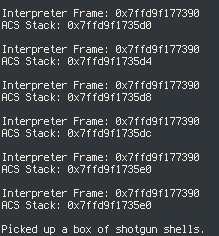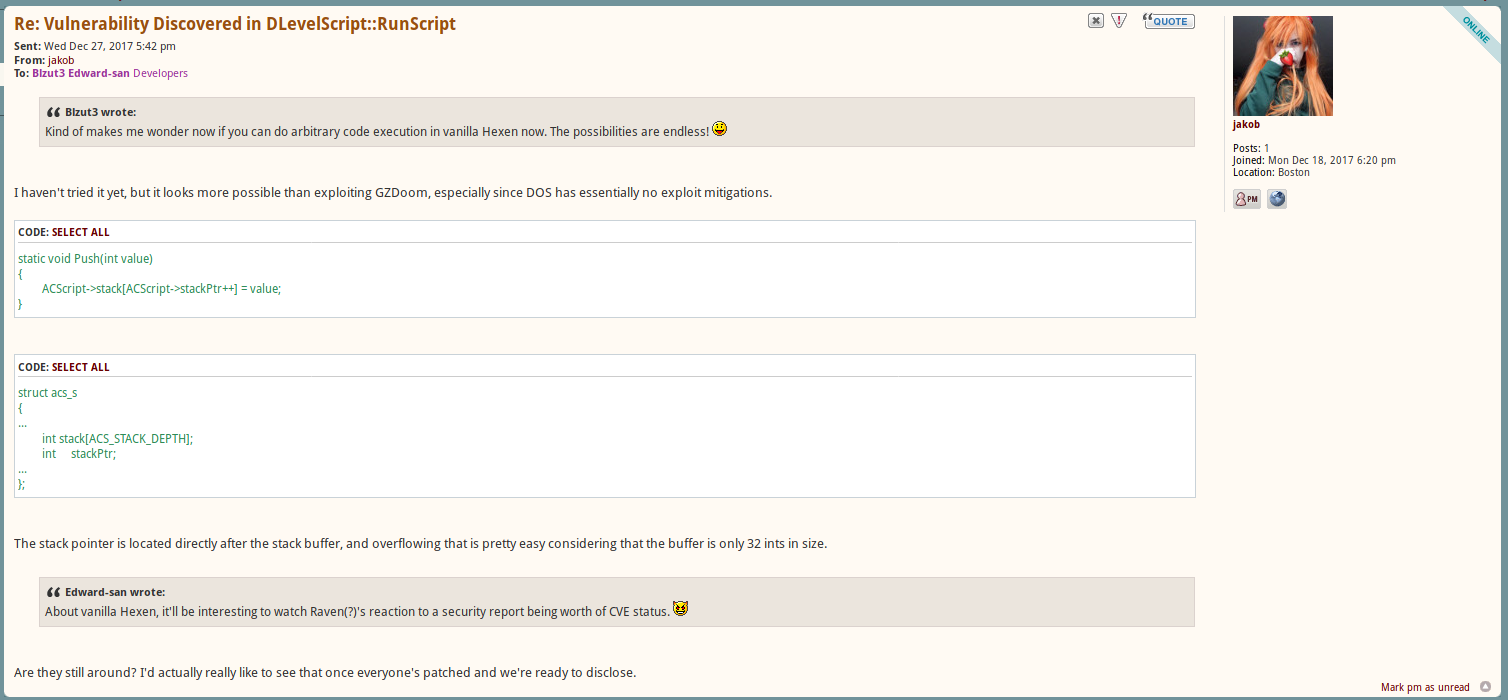TL;DR, I discovered a stack-smashing vulnerability in GZDoom's interpreter for ACS. As a preface, there's a tendency for whitepapers like this in the security community to be written with a somewhat condescending tone towards the product's vendor. I do not mean for any portion of this writeup to come off as degrading to the developers involved. Yes, the bug was obvious to me, but it was still subtle enough that it went under the radar for nearly 23 years. Most developers aren't actively thinking about this kind of attack while writing a bytecode interpreter. I have an enormous amount of respect for the development teams of both GZDoom and Zandronum, who were quick to issue a patch addressing the issue and were respectful of my wishes to release this whitepaper to the public. I'd also like to thank everyone I had the pleasure of working with during this process; it warms my heart to know that the communities behind these open-source software projects are this friendly.
Documentation and exploit code are available here, which is where I would like to direct any source port maintainers. There is a good chance that your port is vulnerable, and the patch to fix it is not overly-complicated.
—
It's been a little over a year and a half since my first capture-the-flag competition. In that time, I've exploited countless binaries, all simulated. Popping a shell had no impact, no consequences within the real world. Recently, though, I've experienced somewhat of a wake up call. The day has finally come that I've discovered a security-critical bug in the wild to call my own.
The research was impromptu, motivated by a few things I noticed while working away on a map for Doom. If you want to script events in Doom, such as a boss spawning and text appearing on the screen when the player flips a switch, you use a somewhat obscure DSL called ACS. The language was designed in the 90's for Hexen, a game intended to run on MS-DOS, so the implementation is full of design decisions that seem archaic nowadays. For one, scripts are compiled ahead of time into a bytecode object, which is then stored in a map's BEHAVIOR lump, and finally run on a stack machine that has access to the game's state.
ACS bytecode isn't completely unfamiliar to me; I wrote a disassembler for it a while ago in an attempt to learn more about radare2's internals. Despite this, the idea that the interpreter for it might allow some foul play to go by didn't cross my mind until I was actually working with ACS on the source code level. The language is, to say the least, hacked together. The type system is extremely weak, and on a low level, the only type it understands is int. There's support for strings, but they're an index into a table in the bytecode object, which can lead to some interesting behavior. Take this valid ACS code, for example:
script 1 ENTER {
print(s:"You picked the wrong house, foo'!");
// Also displays "You picked the wrong house, foo'!"
print(s:0);
}
String constants are casted to the index at which they are located in the string table, which means you can do math with strings - albeit a little less intuitive than string math in Javascript.
script 1 ENTER {
// Displays "1" (Since that's 0 + 1)
print(d:"First String" + "Second String");
}
There are a handful of other quirks, such as the fact that arguments can be
omitted when you invoke a function. The fragile nature of ACS made me want to
look at GZDoom's implementation to see if it would reject any code that does
things it shouldn't. What I initially had in mind was pulling something out of
the string table that doesn't exist, but when I cracked open the source code to
look at PCD_PRINTSTRING, I noticed something a little more sinister.
case PCD_PRINTNUMBER: work.AppendFormat ("%d", STACK(1)); --sp; break;
Hm? It looks like the stack pointer is decremented without any bounds checking. This is C++, though, and it's entirely possible that this is operator overloading, so I looked at how the interpreter's stack was implemented.
FACSStack stackobj; int32_t *Stack = stackobj.buffer; int &sp = stackobj.sp;
No, it isn't operator overloading. This is bad. As an adversary who can
manipulate the bytecode in a BEHAVIOR lump, we have complete control over an
index into a buffer. Let's take a peek at FACSStack.
struct FACSStack { int32_t buffer[STACK_SIZE]; // STACK_SIZE is 0x1000 int sp; FACSStack *next; FACSStack *prev; static FACSStack *head; FACSStack(); ~FACSStack(); };
Take note that the stack pointer is adjacent to the buffer. That will be important in the exploit.
Let's start with a few experiments. The first thing I did was add some debug
prints to certain points in the ACS interpreter so that I could see where the
stack pointer is within the program's memory map. Now we can get our hands dirty
with ACS bytecode. At the time I was performing this research, I didn't know how
everything in the BEHAVIOR lump contributed to the final image, so I spent about
a half hour figuring out how to create a valid bytecode object by looking at
different BEHAVIOR lumps in a hex editor. What I should have done was slowed
down and looked at FBehavior::Init in p_acs.cpp, but whatever, my way worked
with some trial and error. If you want to play with hand-writing ACS bytecode on
your own, you can use my exploit code as a base. Just alter the "payload" array
to contain the bytes you want to have run.
Now, this is where the post is going to get a little confusing, since I have to talk about two entirely different stacks. For the remainder of this whitepaper, I'll refer to the ACS interpreter's stack as "VStack," and the GZDoom process's stack as "SStack."
Initially, I showed off the implementation of PCD_PRINTNUMBER, but something
that decrements the VStack pointer isn't desirable. Let me explain - the SStack
grows downwards on x86; that is, the SStack pointer starts at a very high
address and decreases as you push things onto the SStack. The VStack works in
the opposite direction: as you push things onto the VStack, the VStack pointer
increases. We want to traverse the SStack to the return address, which was
pushed before our script began execution, so we want an opcode that increments
the VStack pointer instead of one that decrements it. Fortunately, this isn't
difficult to find.
case PCD_PUSHBYTE: PushToStack (*(uint8_t *)pc); pc = (int *)((uint8_t *)pc + 1); break;
Where PushToStack is a macro defined as:
#define PushToStack(a) (Stack[sp++] = (a))
So the exploit will overwrite the locals in the interpreter's stack frame, but
there's only really one variable we have to worry about borking, which I'll talk
about in a little bit. Let's jump in and craft a BEHAVIOR lump which calls
PUSHBYTE a bunch of times.

We seem to end prematurely, which is because we hit the stack pointer. We will
have to modify our exploit to step over it somehow, which we can do by
overwriting the stack pointer to a value which points beyond it. Notice,
however, that PUSHBYTE increments the stack pointer by a whole four bytes.
When we push a byte, we're actually pushing a 4-byte integer with the high bytes
all set to 0, so we can't overwrite the stack pointer one "byte" at a time.
Fortunately, there is another ACS opcode, PCD_PUSHNUMBER, which pushes a full
4-byte integer.
With some fiddling in GDB, we can find that the distance between the stack
buffer and where the return address is 4122 bytes. So we actually kill two birds
with one stone by smashing the stack pointer - the offset to the return address
is small enough that the desired stack pointer value fits into a 4 byte word. As
soon as we overwrite the stack pointer, we're at the return address. I suppose
maybe we killed three birds with one stone here, since we jumped over the stack
canary, too. Now we're at the fun part and can overwrite the return pointer with
another call or two to PCD_PUSHNUMBER. My exploit code writes
0xdeadbeefcafebabe, for the reason that it's recognizable in a stacktrace, but
theoretically you could overwrite the least significant bytes of the return
address and jump somewhere in GZDoom's .text segment, bypassing ASLR.
We have complete control over the instruction pointer. Also, while I was disclosing this to the development team, we discovered that vanilla Hexen has this same arbitrary code execution vulnerability. No proof-of-concept yet.


Comment form